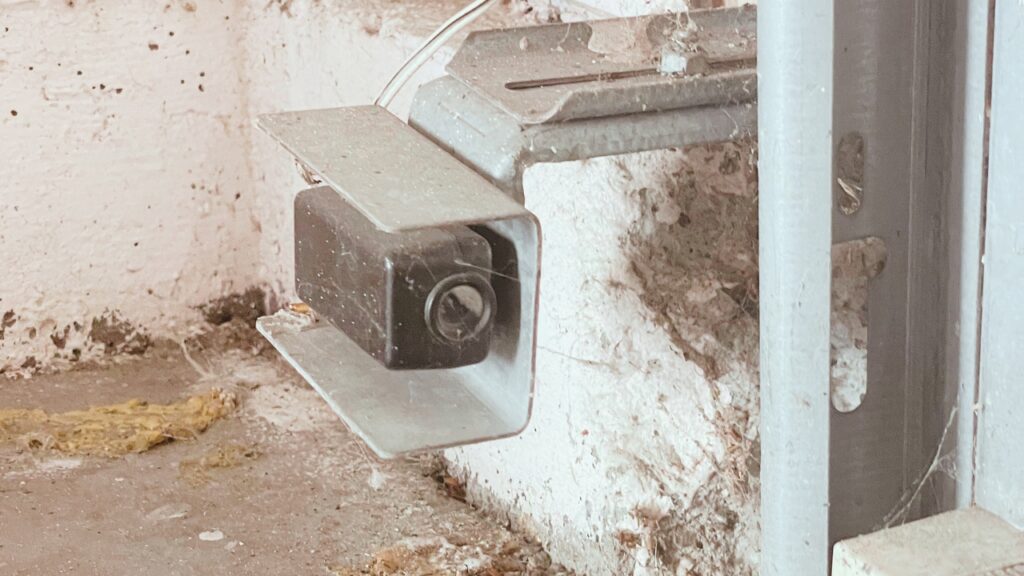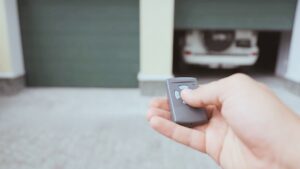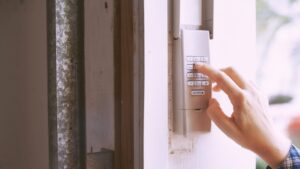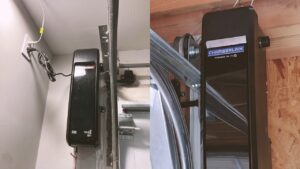Connect With A Garage Expert
Connect with local experts, Compare quotes, Get the best price.
Opening and closing the garage door is an everyday routine for most homeowners. These compact devices are vital in operating and securing your garage door system.
A garage door sensor consists of two small units mounted on either side of the door opening. One unit emits a steady infrared beam or magnetic field across the entrance to the other unit. This prevents the door from closing on people that may be in the way.
In this article, we will take a closer look at how does a garage door sensor work. We’ll also discuss standard sensor issues and how to fix them so your garage door system operates safely.
What is a Garage Door Sensor?
A garage door sensor is a small electronic device, usually made of plastic, that is a crucial safety component of any automated garage door system. Garage door sensors work in pairs and are mounted on opposite sides of the door opening. They work as an invisible transmitter beam across the space. The sensor emits infrared or magnetic rays to the other sensor.
Garage door sensors are an essential safety component that prevents garage doors from closing shut on people, pets, or objects in the doorway. They continuously monitor the opening and trigger the door to stop and reverse if an obstruction is detected. Without functioning sensors, the automated garage door could cause severe injury or damage to vehicles and property.
How Does a Garage Door Sensor Work?
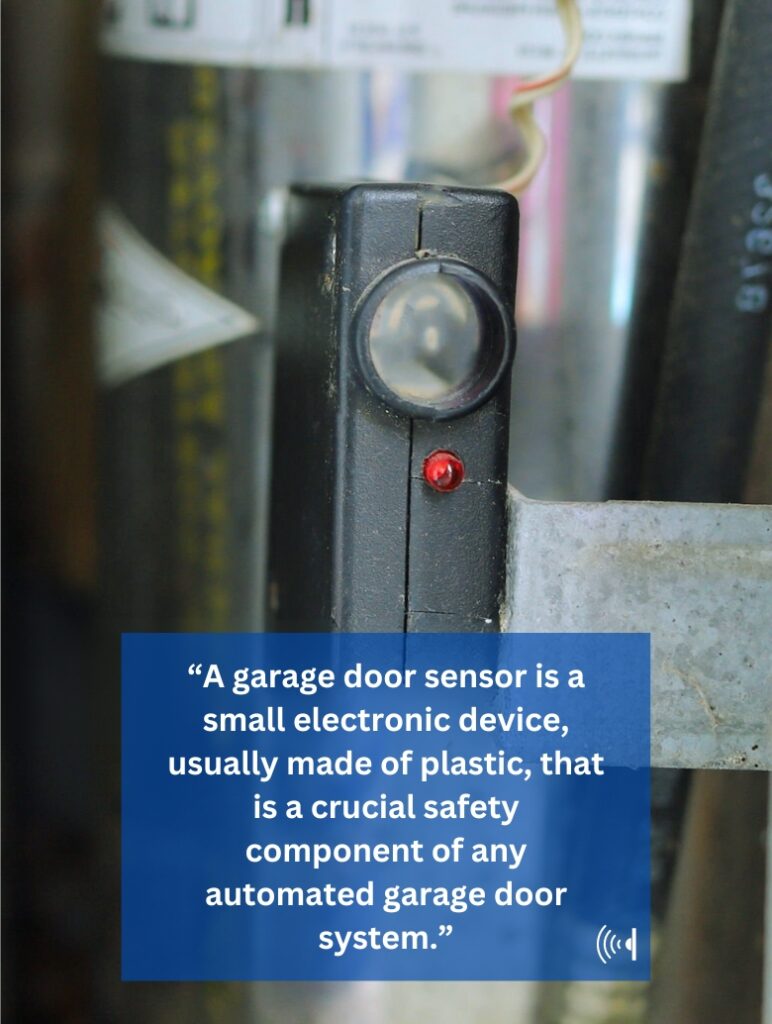
Garage door sensors are designed to be mounted on opposite sides of the garage door opening, typically 6 inches off the ground. One sensor is placed on the left side of the space, while the other is placed on the right side. This strategic placement enables the sensors to monitor the opening from both sides continuously.
Placing the garage door sensors on either side of the opening provides convenience. It allows the sensors to be installed unobtrusively, keeping them out of the way but still adequately positioned to detect obstructions. Their slim, compact design makes them easy to mount without being conspicuous or interfering with garage access.
The garage door sensors work hand-in-hand with the opener. They constantly communicate about whether the doorway is clear or obstructed. This allows the system to operate smoothly, closing the door when the sensors detect the opening is clear and reversing it when they detect something blocking the beam.
Common Issues Regarding Garage Door Opener Sensors
Garage door sensors play a critical safety role, but like any device, they can encounter issues that lead to malfunctions or errors. One issue that homeowners frequently face is when the sensor is not working, which can prevent the garage door from closing properly or cause it to reverse unexpectedly. This can be due to several factors, including alignment problems, dirt or debris blocking the sensors, or even wiring issues.
Here are the most common problems you might notice with your garage door sensors.
Sensors Obstructions

Obstructions, such as cobwebs, dust, dirt, or debris, tend to accumulate over time and can obstruct the sensor pathway. The outdoor setting of sensors makes them susceptible to natural elements like dust and debris carried by wind or settling from the environment.
Small objects, like leaves or twigs, may also be carried by the wind and land in the sensor’s path, causing repeated disruptions to the communication between sensors. Accumulation of dust and debris, as well as interference from external factors, can cause disruptions in the communication and performance of the sensor.
Solutions:
- Regularly clean sensors and remove any accumulated obstructions.
- Check for persistent alignment problems and adjust sensors if necessary.
Dirty Lens

Dirt, dust, and grime accumulate on sensor lenses primarily due to their placement in outdoor environments. Being outdoors exposes sensors to natural ingredients such as wind-blown debris, airborne particles, and pollen.
The outdoor setting creates an environment where particles in the air settle on the sensor surfaces over time, gradually forming layers that hinder the clarity of the lenses.
Solutions:
- Periodically wipe down sensor lenses with a soft cloth.
- Implement preventive measures to minimize constant dirt buildup.
Misaligned Sensors
Misalignment can occur when sensors are inadvertently displaced, either by collisions with objects or due to natural shifting and vibration. Bumps from a vehicle, for example, can nudge the sensors out of their optimal alignment.
Additionally, natural settling or vibrations, perhaps caused by nearby construction or heavy machinery, can contribute to the gradual misalignment of the sensors.
Solutions:
- Loosen mounting brackets slightly and adjust units until lights indicate proper alignment.
- Ensure sensor lenses are pointed directly at each other across the door opening.
Power Supply Issues
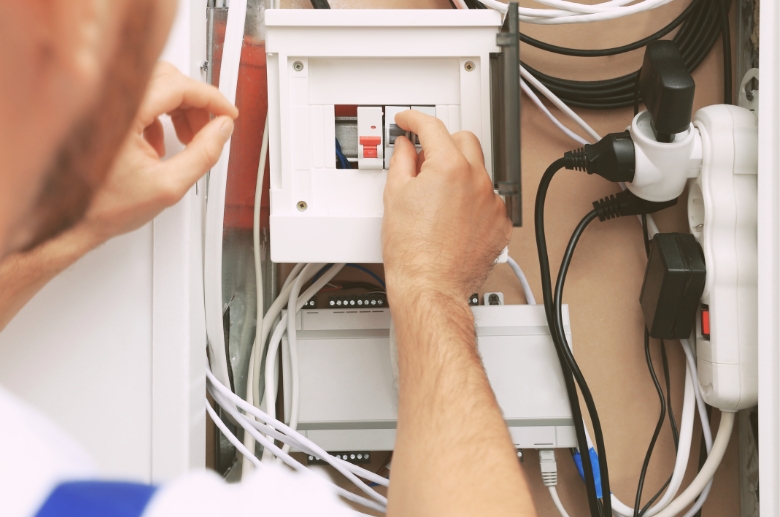
Power-related issues may arise due to various factors, such as loose wiring connections, dead batteries, or electrical shorts. Loose or improperly connected wiring can result in disruptions to the power supply, impacting the functionality of the sensors. Dead batteries in wireless sensor systems can lead to a lack of power, causing issues with properly operating the sensor mechanism.
Additionally, electrical shorts or damage to sensor power cables can contribute to power-related problems, affecting the overall operation of the garage door sensors. Addressing these power-related concerns is crucial for maintaining the reliable performance of the sensors.
Solutions:
- Regularly check and secure all wiring connections.
- Replace batteries periodically.
- Inspect and repair any damaged power cables.
Connect With A Garage Expert
Connect with local experts, Compare quotes, Get the best price.
Damaged Wires
Connectivity and signal issues can arise from damaged, cut, or frayed sensor wires, typically resulting from contact with moving doors or vehicles. The physical strain on the wires, especially when in close proximity to doors in motion, can lead to wear and tear. Inadvertent contact or entanglement with vehicles in the garage area can further contribute to the degradation of the sensor wires connecting the transmitter and receiver units.
Solutions:
- Regularly inspect sensor wires for any signs of damage.
- Promptly replace any degraded or damaged cables.
- Take precautions to protect wires from contact with moving parts.
Interference from Sunlight
Sunlight interference may occur when bright sunlight directly shines on sensors, overloading the system, especially during low-horizon sun conditions. The intensity of sunlight can overwhelm the sensor’s capabilities, leading to errors or malfunctions.
This phenomenon is particularly prominent when the sun is positioned at a low angle, casting horizontal light directly onto the sensors. Under such conditions, the sensors may struggle to interpret signals accurately, resulting in potential disruptions to the garage door system.
Solutions:
- Adjust sensor angles to avoid direct sunlight.
- Use covers to shield sensors and prevent interference from sunlight.
Moisture Around the Sensors
Moisture, whether from exposure to water or excess dampness from condensation, can lead to short circuits and malfunctions. Additionally, improperly sealed or damaged sensor casings may allow moisture to leak in.
Solutions:
- Wipe up any visible moisture around sensors or wiring immediately.
- Mount sensors in protected spots away from water sources.
- Ensure sensor casings are adequately sealed and undamaged to prevent moisture leaks.
Final Thoughts
Garage sensors are a key safety component in automated systems. They work by transmitting invisible beams that detect obstructions and trigger the door to reverse.
Faulty sensors in garage doors can be complex to diagnose and fix and may require professional help for a safe resolution to the problem.
Ready to enhance the safety and convenience of your home with advanced garage door sensor technology? Schedule a free consultation today and ensure your garage security is top-notch!
FAQs
Can a garage door work without sensors?
No, a garage door cannot safely operate without sensors. Garage door sensors, also called safety eyes or photo eyes, are a required safety component of all automated garage door systems in the United States. Federal law mandates that all automatic garage doors have an approved safety device, with photo-eye sensors being the most common.
Garage door sensors work by sending invisible beams between two units located on opposite sides of the door. When something breaks this beam while the door is closing, the sensor identifies it and alerts the opener to stop and reverse the door. This helps keep your property and family safe.
Do garage door sensors wear out?
Like any electronic and mechanical device, garage door sensors do eventually wear out over time. The sensors contain electronic components that can degrade as well as moving parts subject to friction. Constant opening and closing of the garage door can cause vibration and stress on the sensor units, which can eventually lead to malfunction.
While high-quality garage door sensors can last for many years with proper maintenance and care, general wear and tear will cause them to deteriorate after prolonged use. Key signs that sensors need replacement include inconsistent performance, sensor lights not activating properly, and the door reversing unexpectedly.
How do you know if you have a bad garage door sensor?
A malfunctioning garage door sensor is evident when the door fails to reverse upon encountering an obstruction during closure. Testing involves placing an object in the door’s path; if it doesn’t reverse and fully closes on the object, it signals a sensor issue. Look out for additional signs like flashing lights, no lights, or lights of the wrong color on the sensors.
Signs of garage door sensor issues include unexpected door reversals, inconsistent remote operation, and delays in opening or closing. If manual realignment of dirty or misaligned sensors doesn’t solve the problems, it suggests potential hardware failure.

